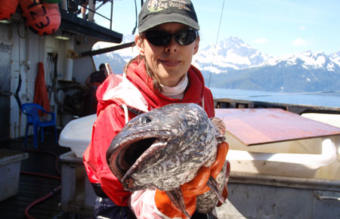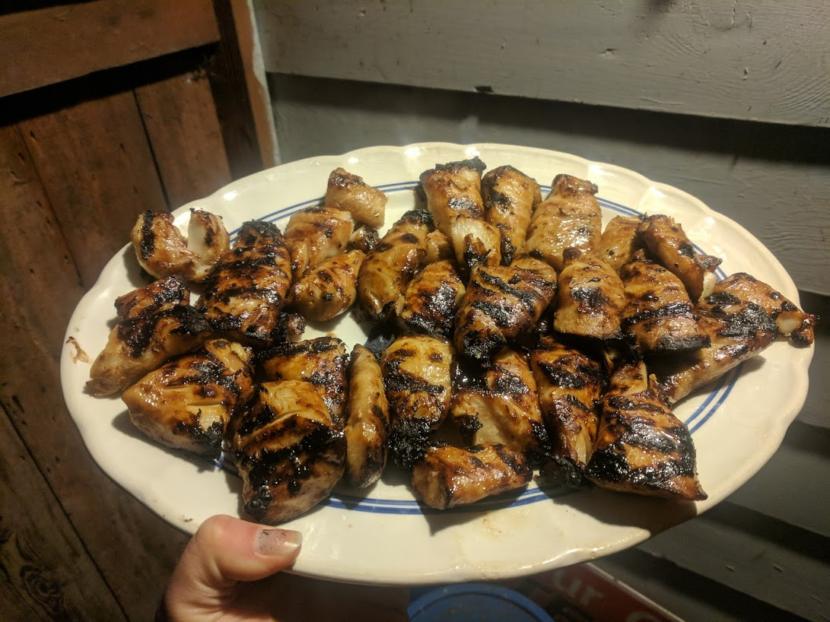
Fish politics in Alaska usually get serious when there aren’t enough fish to go around. But a new fight is brewing over black cod because there are so many of them — possibly as a result of the ocean’s warming waters.
Record numbers of young black cod, also known as sablefish, are swimming off Alaska’s coast; scientists estimate that this group of fish, which had huge reproductive success in 2014, is twice the size of the next-largest on record, from 1977.
The small-boat fishermen who catch black cod, many of whom live in Southeast Alaska, are eagerly waiting for the young fish to grow larger and commercially valuable. But they’re getting frustrated seeing increasing numbers of black cod caught accidentally, as bycatch, by the Seattle-based trawlers that target lower-value species in the Bering Sea, like the pollock that go into McDonald’s Filet-O-Fish sandwiches.
“This recruitment event is what we’re counting on to keep the fishery going for the next 10 or 15 years,” said Tad Fujioka, a Sitka fisherman who decided to buy black cod fishing rights a few years ago, in part because of the boom in their numbers. “We need to save these fish for years to come.”
Much of Alaska’s commercially-sold black cod is caught hundreds of miles east of the Bering Sea. But they’re known to swim long distances, so the small-boat fishermen worry that they’ll have fewer left over after the trawlers’ accidental catches.
“You can’t catch these fish twice,” Bob Alverson, who heads a Seattle-based group of small-boat fishermen, testified at a meeting of fisheries managers last week. “So if they die out there, they’re not likely to have a chance at migrating back.”
The trawlers’ black cod catch is approaching what was previously set as the “overfishing level” for the Bering Sea. That could lead to restrictions being placed on fishermen. Fisheries managers are expected to decide in the next few months whether to raise that limit.
Representatives for the trawlers, meanwhile, say that skippers are encountering much larger numbers of black cod mixed in with the fish that they’re targeting – even though they haven’t changed their fishing practices. Trawlers, who tow a large, open-mouthed net through the water, are already trying to avoid other species like king salmon and herring, and that makes it harder to stay away from black cod.
“We try and go shallow to avoid them and they’re shallow. We try to go deep — I knew one guy who went to over 200 fathoms fishing for pollock, and he still got sablefish,” Brent Paine, a trawl industry representative, testified at last week’s meeting. “It’s very hard to try and avoid them.”

Bering Sea trawlers had pulled up nearly 2,500 metric tons of sablefish by late September — about 10 times what they caught in all of 2016.
“This is really uncharted waters,” Paine said. “We never even dreamed that sablefish would be an incidental catch problem.”
Scientists note that while the trawlers’ accidental catch is way up, it’s still relatively small in the context of the booming black cod numbers. This year’s catch by the Bering Sea trawlers is less than 1 percent of the total amount of the fish between two and five years old estimated to be present in Alaska waters, according to Dana Hanselman, a Juneau-based federal fisheries scientist and black cod expert.
And reports continue to come in that even younger black cod are also present in large numbers — people have been finding salmon bellies full of them, said Hanselman.
Hanselman said researchers are starting to think that Alaska’s warming ocean temperatures could be playing a role in black cod’s increasing numbers.
“They’re a long lived species, and that allows them to span across poor and favorable environmental conditions,” he said. “What we’re seeing now, perhaps, is that sablefish are one of the winners of this marine heatwave that we’re kind of seeing.”
At least one laboratory study backs up that idea — Juneau-based scientists found that black cod grew faster and did better in warmer temperatures, up to a certain point. But, Hanselman added, it’s too early to draw firm conclusions about the cause of the fish’s abundance.
“It’s just an interesting thing we’re observing at the moment and saying, ‘Wow, this really seems to correspond with this high heat wave,’” he said.

Scientists have observed similar trends with sablefish all along the west coast, Hanselman added. One theory is that because sablefish are more mobile, they can move toward warmer temperatures when they’re advantageous, he said.
But the small-boat fishermen who target black cod, generally using long lines of hooks that sit on the ocean floor, are skeptical that they’ll see much benefit from climate change. That’s in part because many of them also fish for other species that could be vulnerable, like salmon.
Fujioka, the Sitka fisherman, said he’s worried about what could happen to the young black cod between now and when they grow to be commercially valuable — and he’s not counting on a long-term boom yet.
“This is just the second time we’ve seen this since 1977. So it seems like you’d want a little more data before you decided that really was a cause-and-effect, and not just a coincidence,” he said. He added: “It would be nice to at least have one winner to put in a pile with a bunch of losers.”

As this year’s fishing season winds down, representatives for the trawlers say they’ve taken measures to try to avoid more accidental black cod catches. One fishing cooperative is requiring members to report all black cod bycatch, with information about location and depth, to a Google group. The captains are being asked to start their trips by catching a small amount of fish, to see how many black cod are present.
For next year, the cooperative plans to set specific bycatch levels that, when reached, will prompt more aggressive management measures, Mark Fina, an official with the group, testified at last week’s meeting. That’s in part because of the way the bycatch problem cropped up so quickly this year, he added.
“I don’t know whether it’s safe to say that something this significant can sneak up on you,” he said. “But I can say that not everybody in the co-op knew what was going on.”
